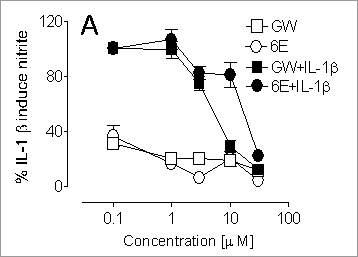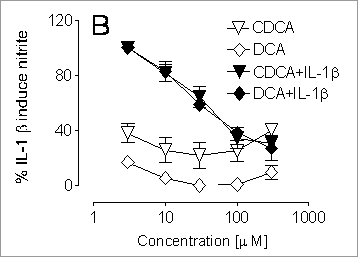Farnesoid X receptor ligands inhibit interleukin-1β stimulated inducible nitric oxide synthase (iNOS) activity in vascular smooth muscle cells
The farnesoid X receptor (FXR; NR1H4)/bile acid receptor belongs to the steroid-like super-family of nuclear receptors . Bile acids such as chenodeoxycholic acid (CDCA) and deoxycholic acid (DCA) are potential ‘physiological’ FXR ligands, while synthetic FXR ligands include GW4064 ( Willson et al ., 2001) and 6α-ethyl-chenodeoxycholic acid (6ECDA) ( Costantino et al ., 2003). As FXR is expressed in the vasculature (Bishop-Bailey et al ., 2004), we have investigated whether FXR ligands regulate IL-1β induced iNOS activity in rat aortic vascular smooth muscle cells (RASMC). WKY3M22 RASMC were cultured as previously described (Bishop-Bailey et al ., 2004). iNOS was induced in RASMC by incubation with IL-1β ( 10ng/ml, 24h) in serum-free medium. FXR ligands, GW4064 (0.1-30 µM; from Dr Eric Niesor, ILEX Corp.), 6-ECDCA (0.1-30 µM; from Dr. Roberto Pellicciari, U. Perugia), CDCA, DCA (3-300 µM) or vehicle were added 1h before IL-1β . In some experiments the selective iNOS inhibitor, 1400W (10 m M) was included . NO was detected as nitrite in the culture medium by the Griess Reaction and cell viability was determined by the MTT assay. Figure 1. Effect of A) synthetic FXR ligands GW4064 (GW) or 6-ECDCA (6E), or B) bile acids CDCA or DCA on nitrite release by RASMC induced by IL-1β . All data represents mean ± S.E.M. of n = 9 from 3 experiments.
IL-1β induced nitrite release over 24h (control: 4±1µM; IL-1β: 18±3µM) that was reduced by 1400W (10 µM; 6±2µM), indicating induction of iNOS. FXR ligands all inhibited IL-1µ induced nitrite in a concentration-dependant manner (Fig. 1), with the synthetic ligands GW4064 and 6ECDCA (Fig. 1A) being more potent than the bile acids, consistent with their activities on FXR. Cell viability was not affected by 6-ECDCA, but was reduced by higher concentrations of GW4064 (10 µM, 57±5 % of control), CDCA (100 µM, 59±4% of control) and DCA (100 µM, 67±4% of control). Both potent synthetic and ‘physiological’ FXR ligands inhibit nitrite induction by IL-1β in RASMC. FXR may therefore be a novel regulator of vascular inflammation.
Bishop-Bailey et al . (2004) Proc. Natl. Acad. Sci. USA 101, 3668-73. This work was funded by the British Heart Foundation (FS/04/075 and BS/02/002). |



